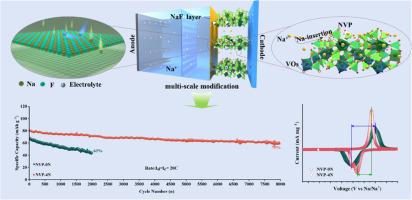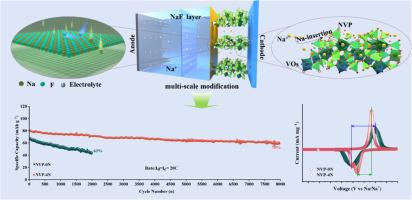Sodium vanadium phosphate electrode achieving rapid Na+ migration kinetics through DBD plasma multiscale modification
IF 20.2
1区 材料科学
Q1 CHEMISTRY, PHYSICAL
引用次数: 0
Abstract
Na3V2(PO4)3 (NVP) has been extensively investigated as an ideal cathode material for sodium-ion batteries owing to its excellent low-temperature performance and abundant sodium resources. However, its low electronic conductivity and poor Na+ diffusion kinetics limit its widespread application. To address these challenges, a fast, efficient, and in situ multiscale modification method for NVP using low-temperature dielectric barrier discharge (DBD) plasma is proposed. At the microscopic scale, oxygen vacancies (O-vacs) are generated in NVP, while at the macroscopic scale, a superstable, Na+-conductive NaF layer is created on the electrode surface. Combining COMSOL Multiphysics simulations and density functional theory calculations, the mechanism of O-vacs in the NVP crystal structure and NaF layers at the electrode interface is confirmed by high-energy electron bombardment in N2 DBD plasma with a maximum energy value of 11.25 eV. This energy considerably exceeds the O-vac formation energy (0.26 eV) and the C–F bond-breaking energy (5.02 eV). The strategic introduction of abundant O-vacs into NVP crystal lattices enhances Na+ diffusion kinetics and electronic conductivity. The in situ formation of NaF layers at the electrode interface suppresses the generation of Na2CO3 with extremely low Na+ conductivity. This multiscale synergy of bulk-phase defect engineering (O-vacs) and interfacial chemistry optimization (NaF) considerably improves ionic and electronic transport dynamics throughout the electrode system. The optimal NVP electrode with N2 plasma modification of 4 min (NVP-4N) exhibits a stable capacity of 81.1 mAh g−1 with 75 % capacity retention over 8000 cycles at 20C. The capacity is enhanced by 18 % with a threefold improvement in cycling performance compared to the 68.9 mAh g−1 capacity after 2000 cycles of the NVP electrode without modification. Even at a high current density of 40C, it still demonstrates a capacity of 76.5 mAh g−1 with 73 % retention over 7000 cycles. This work provides new insights into the application of low-temperature plasma in modifying energy materials at multiple spatial scales.


通过DBD等离子体多尺度修饰实现快速Na+迁移动力学的磷酸钒钠电极
Na3V2(PO4)3 (NVP)由于其优异的低温性能和丰富的钠资源,作为一种理想的钠离子电池正极材料得到了广泛的研究。但其电导率低,Na+扩散动力学差,限制了其广泛应用。为了解决这些问题,提出了一种快速、高效的低温介质阻挡放电(DBD)等离子体原位多尺度改性NVP的方法。在微观尺度上,NVP中产生了氧空位(O-vacs),而在宏观尺度上,电极表面形成了超稳定的Na+导电NaF层。结合COMSOL Multiphysics模拟和密度泛函理论计算,利用最大能量值为11.25 eV的N2 DBD等离子体高能电子轰击,证实了NVP晶体结构和电极界面处NaF层中O-vacs的机理。该能量大大超过了O-vac的形成能(0.26 eV)和C-F的断键能(5.02 eV)。在NVP晶格中引入大量的O-vacs可以提高Na+的扩散动力学和电子导电性。在极低的Na+电导率下,电极界面处原位形成的NaF层抑制了Na2CO3的生成。这种体相缺陷工程(O-vacs)和界面化学优化(NaF)的多尺度协同作用大大改善了整个电极系统中的离子和电子输运动力学。最佳的NVP电极经过4 min的N2等离子体修饰(NVP- 4n),在20C下,在8000次循环中,NVP电极的稳定容量为81.1 mAh g - 1,容量保持率为75%。与未经修饰的NVP电极2000次循环后的68.9 mAh g−1容量相比,该容量提高了18%,循环性能提高了三倍。即使在40C的高电流密度下,它仍然显示出76.5 mAh g−1的容量,在7000次循环中保持73%的保留率。这项工作为低温等离子体在多空间尺度上修饰能量材料的应用提供了新的见解。
本文章由计算机程序翻译,如有差异,请以英文原文为准。
求助全文
约1分钟内获得全文
求助全文
来源期刊

Energy Storage Materials
Materials Science-General Materials Science
CiteScore
33.00
自引率
5.90%
发文量
652
审稿时长
27 days
期刊介绍:
Energy Storage Materials is a global interdisciplinary journal dedicated to sharing scientific and technological advancements in materials and devices for advanced energy storage and related energy conversion, such as in metal-O2 batteries. The journal features comprehensive research articles, including full papers and short communications, as well as authoritative feature articles and reviews by leading experts in the field.
Energy Storage Materials covers a wide range of topics, including the synthesis, fabrication, structure, properties, performance, and technological applications of energy storage materials. Additionally, the journal explores strategies, policies, and developments in the field of energy storage materials and devices for sustainable energy.
Published papers are selected based on their scientific and technological significance, their ability to provide valuable new knowledge, and their relevance to the international research community.
 求助内容:
求助内容: 应助结果提醒方式:
应助结果提醒方式:


